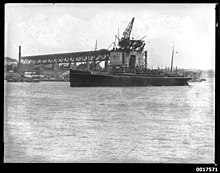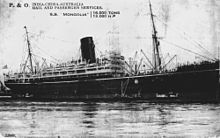Mongolia (ship, 1923)
|
||||||||||||||||||||
|
||||||||||||||||||||
|
||||||||||||||||||||
|
||||||||||||||||||||
|
||||||||||||||||||||
The Mongolia (III) was a 1923 passenger ship of the British shipping company Peninsular and Oriental Steam Navigation Company (P&O), which was used in passenger and mail traffic from Great Britain to Australia . She was sold to New Zealand in 1938 and had a total of four other owners. Decommissioned in 1963, it was scrapped in Japan two years later.
P&O
The 16,504 GRT steam turbine ship Mongolia was built on November 22, 1918 at the Sir WG Armstrong-Whitworth & Co., Ltd. ordered in Newcastle on the Tyne . The construction was delayed due to the post-war repair of existing ships. The 175 meter long and 22 meter wide ship was not launched until August 24, 1922. The construction cost P&O around one million pounds sterling (in terms of monetary value at the time). After completion and the test drives, the Mongolia was handed over to its shipping company on April 24, 1923.
On May 11, 1923, she ran from London on her maiden voyage to Sydney . It could carry 231 first class passengers and 180 second class passengers. The ship initially sailed to Australia every four weeks, but demand for this service dropped rapidly from 1925. In 1928 there was a change from coal to fuel combustion. On July 16, 1933, the Mongolia first collided with the tanker British Venture in Copenhagen and then with a breakwater before running aground. On December 3, 1936, she collided with the motor ship Villa de Madrid near Marseille .
New Zealand Shipping Company

In 1937 the ship was launched and offered for sale because it was no longer profitable. In the following year, P&O transferred the ship to the New Zealand Shipping Company , which had been incorporated into the company years earlier. From 1938 the Mongolia was now used under the name Rimutaka and was registered in Plymouth . She was converted to carry 840 tourists in tourist class. Even before it was commissioned for the New Zealand Shipping Company, the ship collided with the Corfleet at the Nore sandbank in the Thames estuary . After the repairs, the first crossing for the new owners began on December 12, 1938. She sailed the route from London through the Panama Canal to Auckland and Wellington .
On March 9, 1939, a fire broke out in one of the ship's departments. In September of the same year, shortly after the outbreak of the Second World War , the Rimutaka was requested as an armed auxiliary cruiser (Armed Merchant Cruiser). However, she was released from this task again before the conversion could be carried out. She belonged to the Liner Division between May 12, 1940 and June 14, 1946, but remained in civilian passenger service between Great Britain and New Zealand for the duration of the war.
After the war ended, the Rimutaka stayed on its route. In January 1950 she ran from London on her last trip for the New Zealand Shipping Company to Wellington. Then it was returned to the parent company P&O and offered for sale again.
Late years
On March 3, 1950, the ship went into the possession of the Panama-based Incres Compãnía de Navegación ( Incres Shipping Company ), which belonged to the Italian shipping company Home Lines, for £ 95,000 . Under the name Europa , it was converted to accommodate 614 tourist class passengers. The cooling chambers for transporting perishable food have been removed to make more space. From then on, Europe transported stateless emigrants from Europe to the USA and Canada . The ship was now registered in Panama, but the crew consisted of Italians. Until September 1951 the Europa sailed from Genoa and later Antwerp and Le Havre to Halifax and New York .
The ship was then overhauled in Genoa and converted into a cruise ship for the Incres Nassau Line. As Nassau , it cruises from New York to Nassau in the Bahamas . For this purpose, swimming pools and other amenities were created on board. As Nassau , the former Mongolia was the first ship to be used as a cruise ship all year round and not just seasonally. From 1954 Nassau was registered in Liberia .
In 1961, the ship was bought by the Compania Navegacion Turística Mexicana ( Natumex Line ), a shipping company owned by the Mexican government. For the Natumex Line, the ship shuttled between Acapulco and Los Angeles under the new name Acapulco . At Fairfield Shipbuilders in Glasgow, the steamer underwent another overhaul, with a new bow and chimney installed. During the third crossing to California, the ship suffered serious engine damage on the high seas.
During the 1962 World's Fair in Seattle , the Acapulco served as a hotel ship. In 1963 it was launched in Manzanillo . On December 15, 1964, she arrived in Osaka, Japan, for demolition . The dismantling began on January 6, 1965 in Sakai . This ended the more than 40-year career of P & O's third Mongolia .

